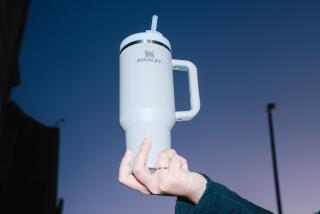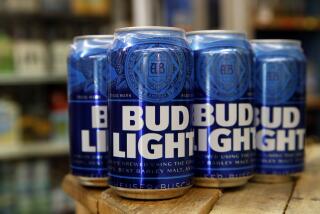Teen Taste for Vodka Ads Raises Concern
- Share via
Allie Kligman, a Rockville, Md., 13-year-old, got hooked on Absolut by her 16-year-old sister, Jillian. The teenagers aren’t interested in what’s inside the vodka bottle. Instead, they scour magazines for Absolut ads for the collection on their walls.
“They’re so creative,” said Allie of the ads, which feature an Absolut bottle in various shapes and settings. One of the most popular carries the slogan “Absolut Hitchcock” on a bottle outline reminiscent of Alfred Hitchcock’s profile. Another, “Absolut San Francisco,” displays the bottle shrouded in fog.
High school and college librarians have resorted to running a black marker through Absolut magazine ads to deter students from ripping them out.
“Absolut Book: The Absolut Vodka Advertising Story” has sold 150,000 copies since its introduction last year.
An electronic Absolut art gallery on the Internet draws teenagers eager to trade from their collections. Some of Allie and Jillian’s friends collect Absolut T-shirts and even a limited edition Absolut tie issued for Father’s Day.
But the campaign’s popularity with those too young to legally drink worries some industry executives that alcohol ads could replace Joe Camel as a target for regulators and consumer advocates.
“The controversies in the cigarette and alcohol industries are identical: Does seeing an ad make you consume?” said Betty Parker, a marketing professor at Western Michigan University. “There’s no question people in all industries are keeping an eye on what’s happened to Joe Camel. What we’re seeing is the possibility that the government is going to get into the business of reviewing advertising.”
Officials at the Federal Trade Commission are investigating some liquor ads--but not Absolut’s--to determine if they are aimed at underage drinkers. Regulators, however, say they are just doing what they have always done: protecting minors from unfair or deceptive advertising.
“We see no similarity with cigarettes or with cigarette ads,” said Distilled Spirits Council spokeswoman Lisa Hawkins. But privately, industry executives say they fear that anti-tobacco groups will focus on alcohol ads to attract funding now that the tobacco battle is winding down. The Beer Institute, a trade group, did not return phone calls.
Marketing specialists say there is no evidence that the ads’ popularity has led to more underage drinking. The appeal, they say, has little to do with alcohol and a lot to do with the witty designs that may refer to such cultural icons as Marilyn Monroe or Andy Warhol.
“Many students see the campaign almost as a work of art rather than as advertising,” said Bob Gulovsen, a marketing professor at Washington University in St. Louis.
A spokesman for Absolut Co. of Sweden said the ads’ popularity with people under the legal drinking age is unintentional and has caused no complaints. “What I hear from parents is that the campaign has introduced their children to a piece of the world of art,” said Richard W. Lewis of TBWA / Chiat Day, the ad agency that created the Absolut campaign.
When it comes to building brand recognition, Absolut ads win big. Sales last year rose 5.2%, largely as a result of the ad campaign, compared with 0.3% growth for liquor sales in general.
Absolut’s success defies the trend in the distilled liquor industry, in which sales have declined 27% since 1980. Lewis said Absolut sales have risen every year since the ad campaign began, lifting annual U.S. sales from 10,000 cases in 1980 to more than 3 million cases last year.
More to Read
Inside the business of entertainment
The Wide Shot brings you news, analysis and insights on everything from streaming wars to production — and what it all means for the future.
You may occasionally receive promotional content from the Los Angeles Times.










